lock YAMAHA SUV 1200 2001 Owners Manual
[x] Cancel search | Manufacturer: YAMAHA, Model Year: 2001, Model line: SUV 1200, Model: YAMAHA SUV 1200 2001Pages: 135, PDF Size: 21.67 MB
Page 18 of 135
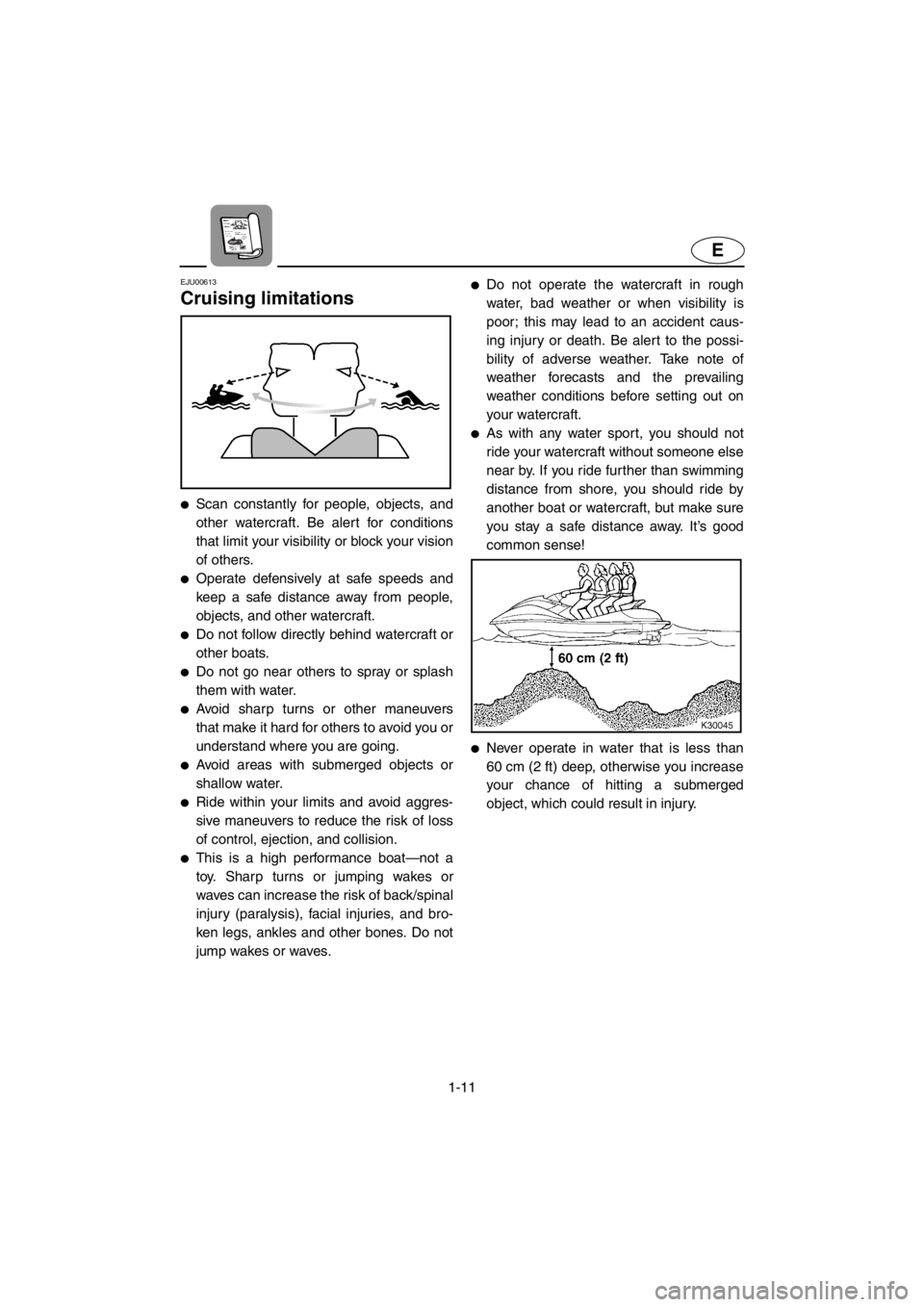
1-11
E
EJU00613
Cruising limitations
●Scan constantly for people, objects, and
other watercraft. Be alert for conditions
that limit your visibility or block your vision
of others.
●Operate defensively at safe speeds and
keep a safe distance away from people,
objects, and other watercraft.
●Do not follow directly behind watercraft or
other boats.
●Do not go near others to spray or splash
them with water.
●Avoid sharp turns or other maneuvers
that make it hard for others to avoid you or
understand where you are going.
●Avoid areas with submerged objects or
shallow water.
●Ride within your limits and avoid aggres-
sive maneuvers to reduce the risk of loss
of control, ejection, and collision.
●This is a high performance boat—not a
toy. Sharp turns or jumping wakes or
waves can increase the risk of back/spinal
injury (paralysis), facial injuries, and bro-
ken legs, ankles and other bones. Do not
jump wakes or waves.
●Do not operate the watercraft in rough
water, bad weather or when visibility is
poor; this may lead to an accident caus-
ing injury or death. Be alert to the possi-
bility of adverse weather. Take note of
weather forecasts and the prevailing
weather conditions before setting out on
your watercraft.
●As with any water sport, you should not
ride your watercraft without someone else
near by. If you ride further than swimming
distance from shore, you should ride by
another boat or watercraft, but make sure
you stay a safe distance away. It’s good
common sense!
●Never operate in water that is less than
60 cm (2 ft) deep, otherwise you increase
your chance of hitting a submerged
object, which could result in injury.
E_GU5-71-1.fm Page 11 Thursday, July 13, 2000 8:53 PM
Page 27 of 135

E
2
EJU00326
FEATURES AND
FUNCTIONS
Location of main components............... 2-1
Operation of controls and other
functions.................................................... 2-4
Rear seat................................................. 2-4
Front seat ................................................ 2-5
Hood ........................................................ 2-6
Fuel tank filler cap ................................... 2-7
Oil tank filler cap...................................... 2-7
Fuel cock knob........................................ 2-8
Engine stop switch .................................. 2-9
Engine shut-off switch............................. 2-9
Choke knob ............................................. 2-9
Throttle lever ......................................... 2-10
Start switch............................................ 2-10
Cooling water pilot outlet ...................... 2-11
Steering system .................................... 2-11
Tilt lever ................................................. 2-12
Shift lever .............................................. 2-13
Quick Shift Trim System (QSTS)
selector .................................................. 2-14
Engine overheat warning system ......... 2-16
Handgrip................................................ 2-17
Side grips .............................................. 2-17
Multifunction meter................................ 2-18
PADLOC (Programmable digital locking
ignition) .................................................. 2-19
Tachometer ........................................... 2-21
Speedometer ........................................ 2-22
Fuel meter ............................................. 2-22
Engine oil meter .................................... 2-23
Clock ..................................................... 2-23
Hour meter ............................................ 2-24
Trip timer ............................................... 2-24
Tripmeter ............................................... 2-25
Fuel warning indicator........................... 2-25
Oil warning indicator ............................. 2-26
Engine overheat warning indicator....... 2-26
Battery warning indicator ...................... 2-27
Storage compartments ......................... 2-28
E_GU5-71-2TOC.fm Page 1 Thursday, July 13, 2000 7:48 PM
Page 31 of 135
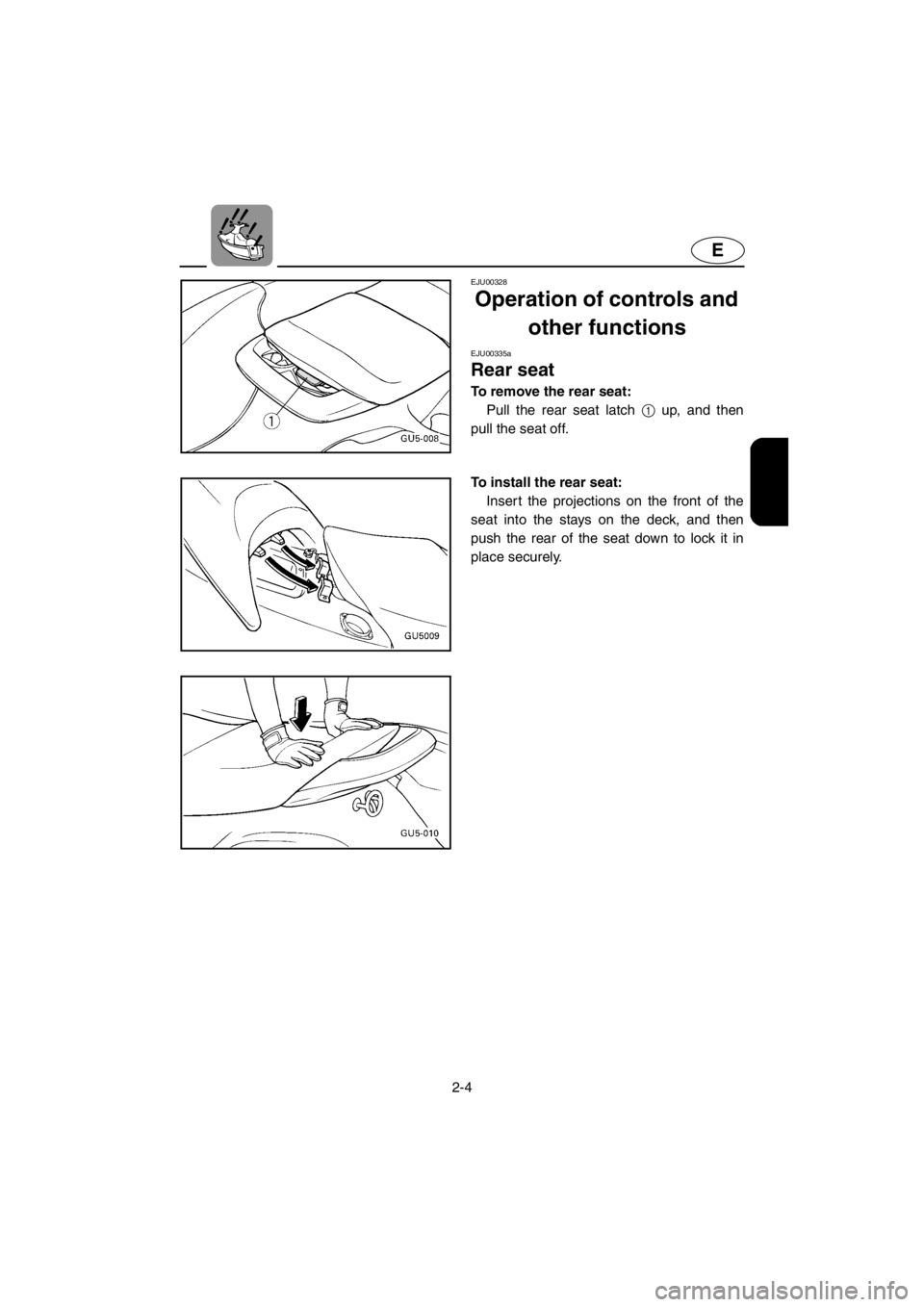
2-4
E
EJU00328
Operation of controls and
other functions
EJU00335a
Rear seat
To remove the rear seat:
Pull the rear seat latch 1 up, and then
pull the seat off.
To install the rear seat:
Insert the projections on the front of the
seat into the stays on the deck, and then
push the rear of the seat down to lock it in
place securely.
E_GU5-71-2.fm Page 4 Thursday, July 13, 2000 7:48 PM
Page 32 of 135

2-5
E
EJU00714
Front seat
To remove the front seat:
1. Remove the rear seat.
2. Pull the front seat latch 2 up, and then
pull the seat off.
To install the front seat:
1. Insert the projections on the front of the
seat into the stays on the deck, and then
push the rear of the seat down to lock it
in place.
2. Install the rear seat.
NOTE:
Make sure that the seats are properly
secured before operating the watercraft.
E_GU5-71-2.fm Page 5 Thursday, July 13, 2000 7:48 PM
Page 33 of 135

2-6
E
EJU00703
Hood
To open the hood, pull the latch 1 up,
and then lift the hood up.
To close the hood, push the hood down to
lock it in place.
NOTE:
Make sure that the hood is properly secured
before operating the watercraft.
E_GU5-71-2.fm Page 6 Thursday, July 13, 2000 7:48 PM
Page 34 of 135
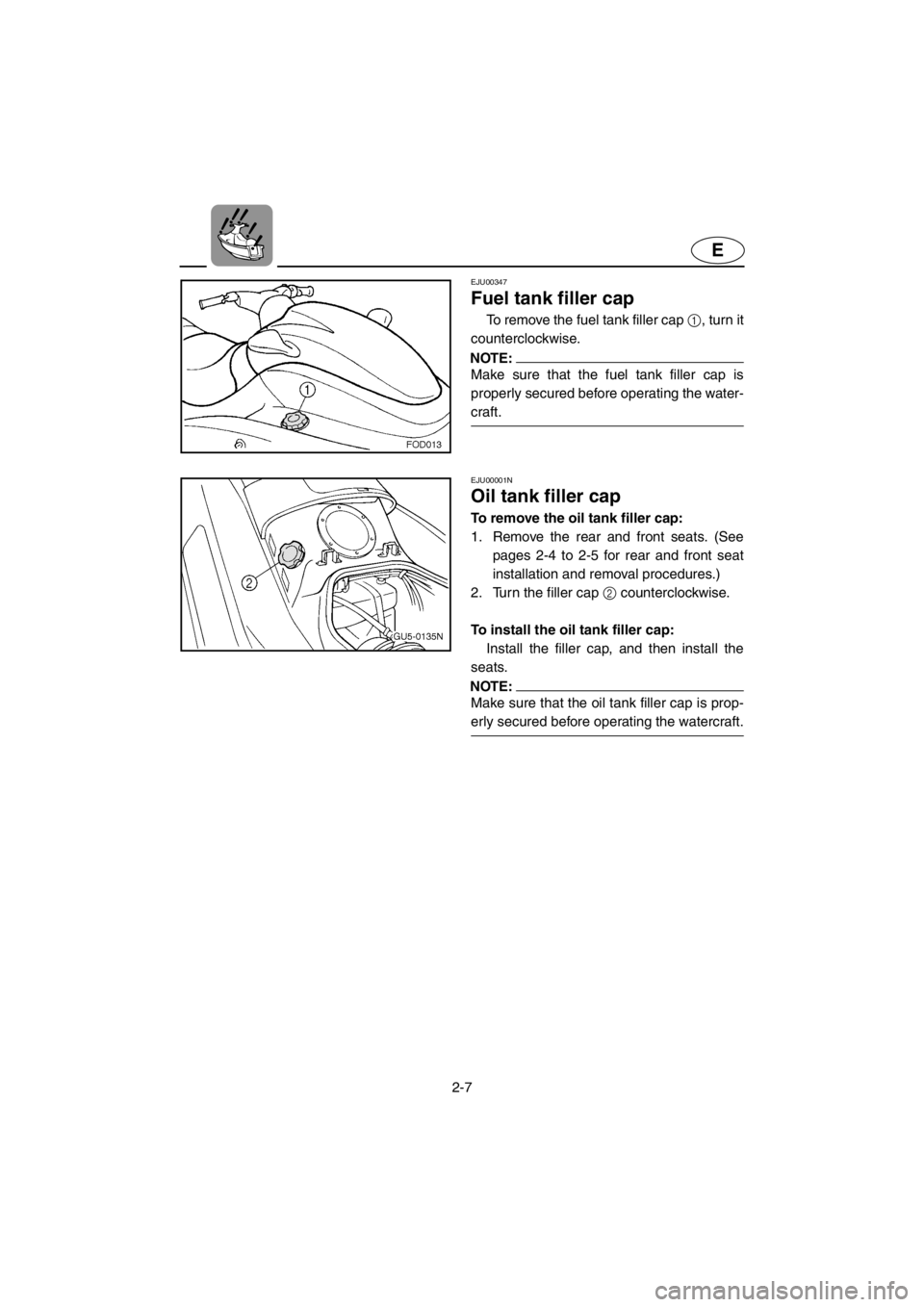
2-7
E
EJU00347
Fuel tank filler cap
To remove the fuel tank filler cap 1, turn it
counterclockwise.
NOTE:
Make sure that the fuel tank filler cap is
properly secured before operating the water-
craft.
EJU00001N
Oil tank filler cap
To remove the oil tank filler cap:
1. Remove the rear and front seats. (See
pages 2-4 to 2-5 for rear and front seat
installation and removal procedures.)
2. Turn the filler cap 2 counterclockwise.
To install the oil tank filler cap:
Install the filler cap, and then install the
seats.
NOTE:
Make sure that the oil tank filler cap is prop-
erly secured before operating the watercraft.
E_GU5-71-2.fm Page 7 Thursday, July 13, 2000 7:48 PM
Page 37 of 135
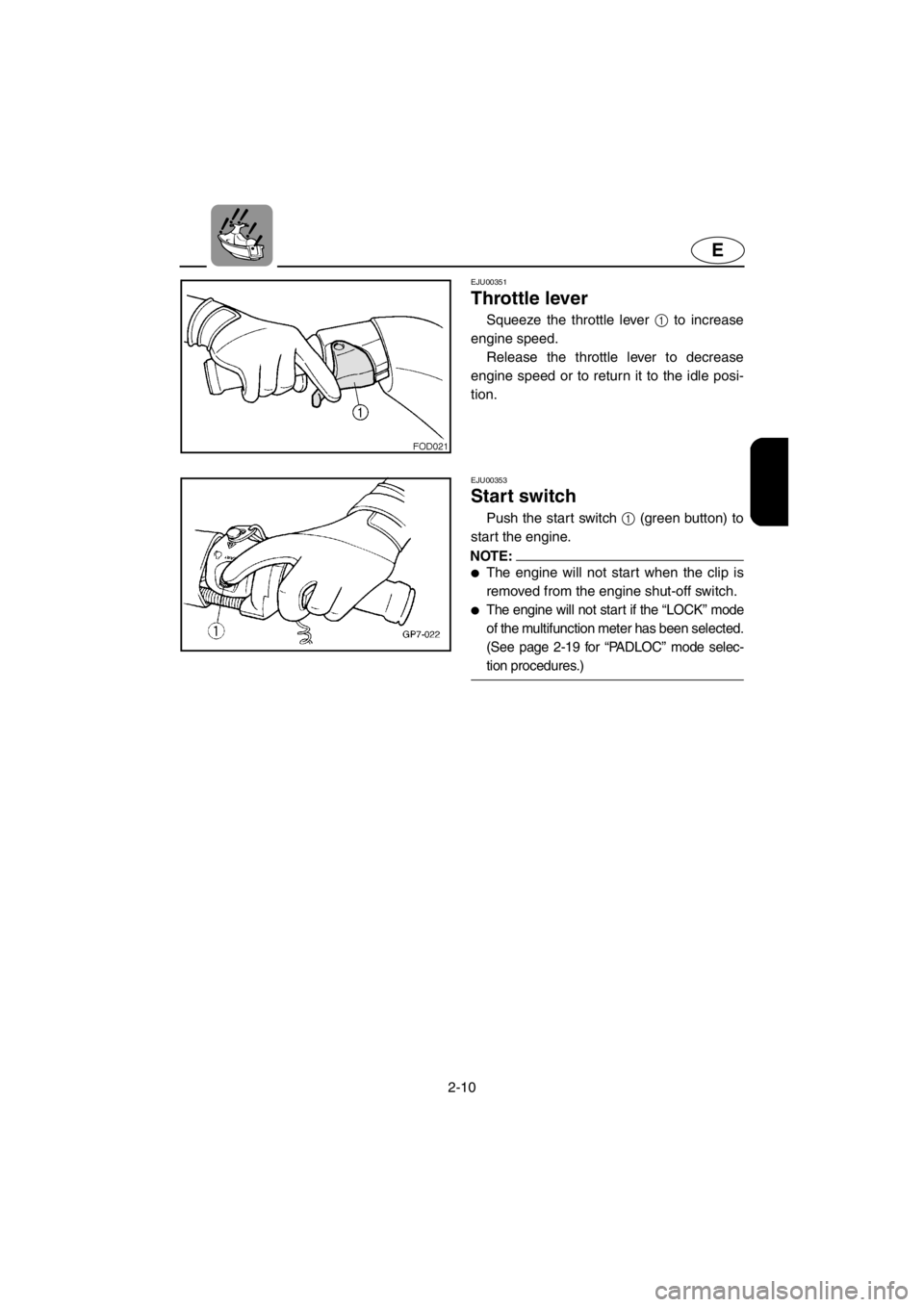
2-10
E
EJU00351
Throttle lever
Squeeze the throttle lever 1 to increase
engine speed.
Release the throttle lever to decrease
engine speed or to return it to the idle posi-
tion.
EJU00353
Start switch
Push the start switch 1 (green button) to
start the engine.
NOTE:
●The engine will not start when the clip is
removed from the engine shut-off switch.
●The engine will not start if the “LOCK” mode
of the multifunction meter has been selected.
(See page 2-19 for “PADLOC” mode selec-
tion procedures.)
E_GU5-71-2.fm Page 10 Thursday, July 13, 2000 7:48 PM
Page 41 of 135
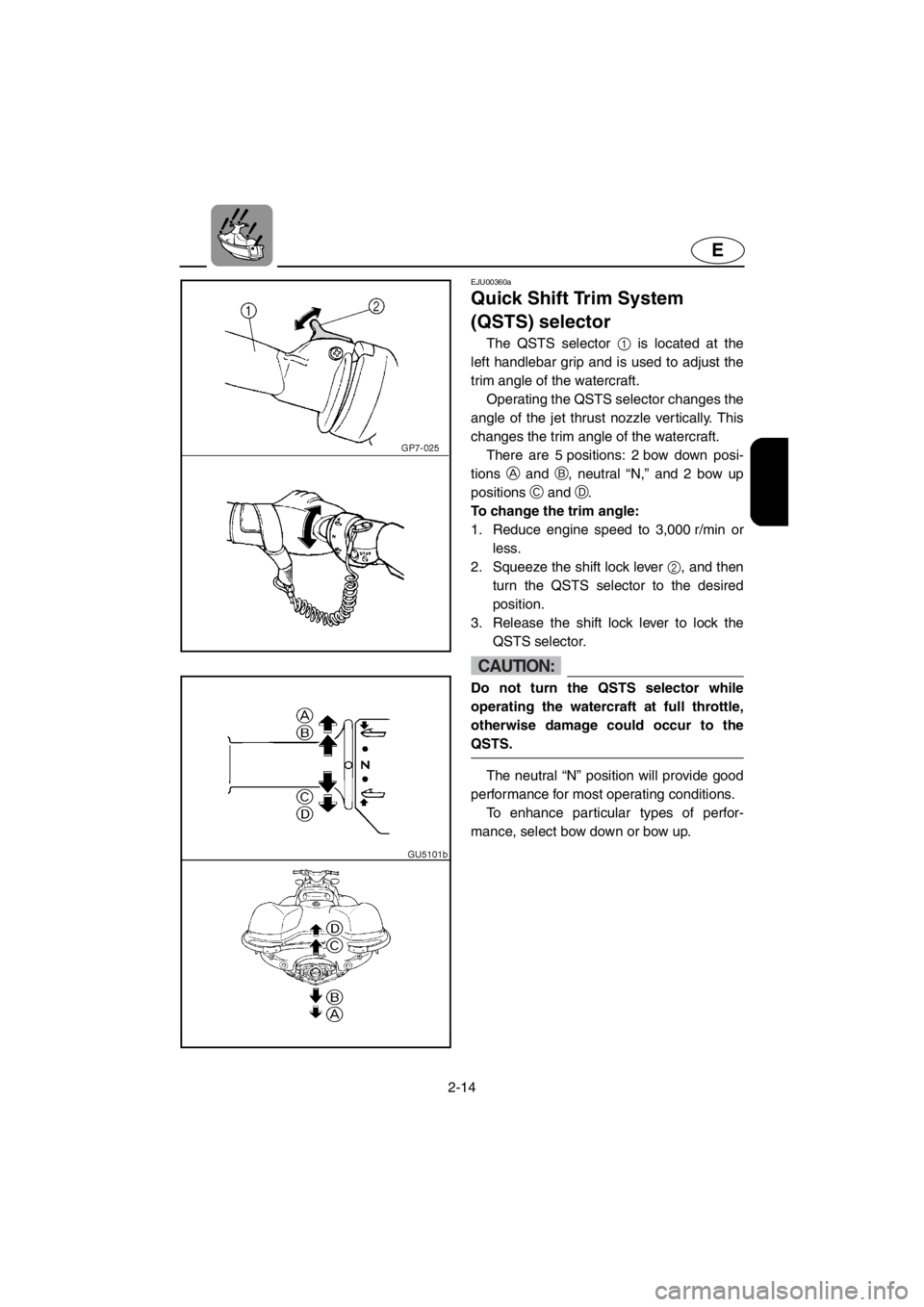
2-14
E
EJU00360a
Quick Shift Trim System
(QSTS) selector
The QSTS selector 1 is located at the
left handlebar grip and is used to adjust the
trim angle of the watercraft.
Operating the QSTS selector changes the
angle of the jet thrust nozzle vertically. This
changes the trim angle of the watercraft.
There are 5 positions: 2 bow down posi-
tionsA and B, neutral “N,” and 2 bow up
positionsC and D.
To change the trim angle:
1. Reduce engine speed to 3,000 r/min or
less.
2. Squeeze the shift lock lever 2, and then
turn the QSTS selector to the desired
position.
3. Release the shift lock lever to lock the
QSTS selector.
CAUTION:
Do not turn the QSTS selector while
operating the watercraft at full throttle,
otherwise damage could occur to the
QSTS.
The neutral “N” position will provide good
performance for most operating conditions.
To enhance particular types of perfor-
mance, select bow down or bow up.
E_GU5-71-2.fm Page 14 Thursday, July 13, 2000 7:48 PM
Page 45 of 135
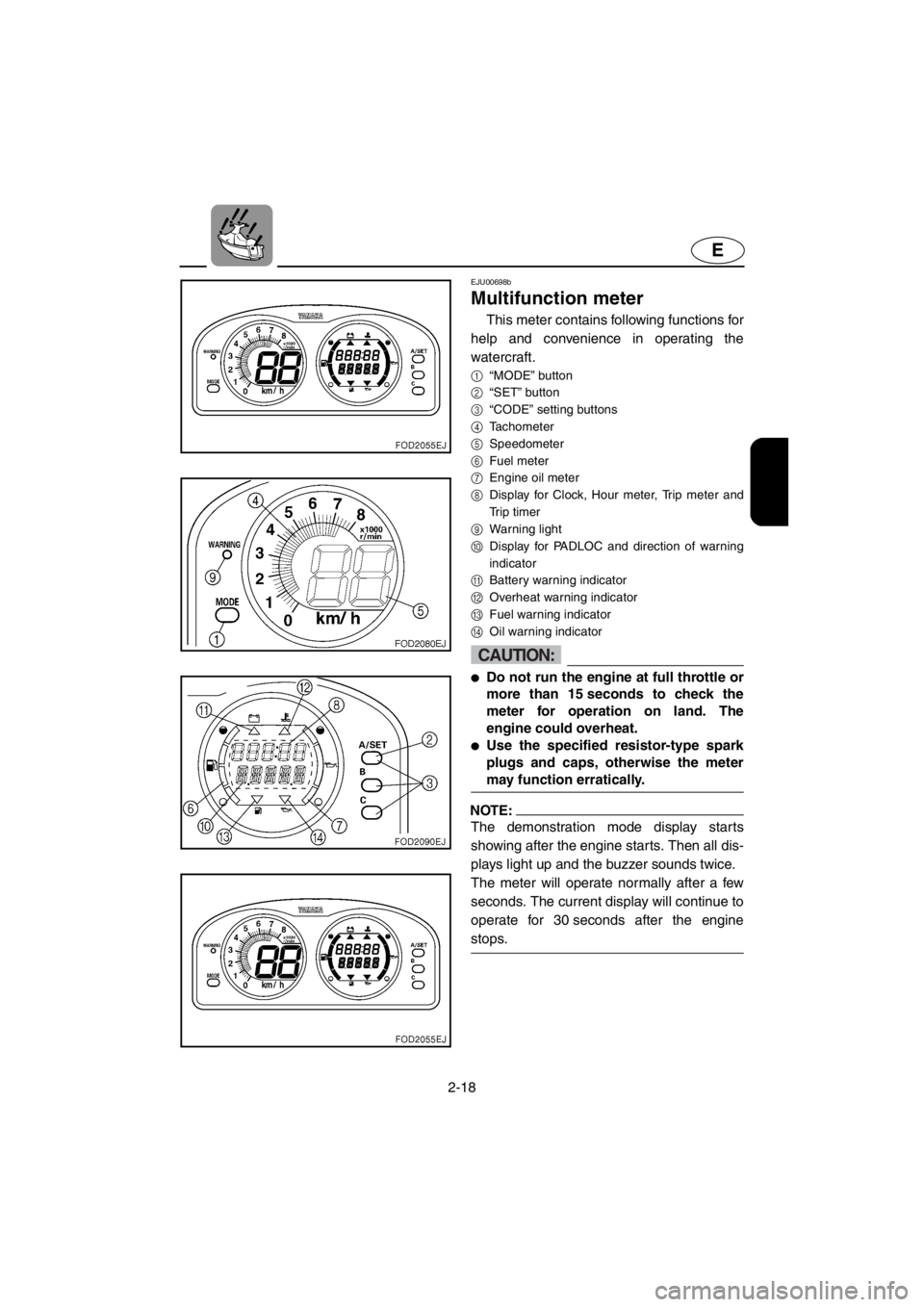
2-18
E
EJU00698b
Multifunction meter
This meter contains following functions for
help and convenience in operating the
watercraft.
1
“MODE” button
2
“SET” button
3
“CODE” setting buttons
4
Tachometer
5
Speedometer
6
Fuel meter
7
Engine oil meter
8
Display for Clock, Hour meter, Trip meter and
Trip timer
9
Warning light
0
Display for PADLOC and direction of warning
indicator
A
Battery warning indicator
B
Overheat warning indicator
C
Fuel warning indicator
D
Oil warning indicator
CAUTION:
●Do not run the engine at full throttle or
more than 15 seconds to check the
meter for operation on land. The
engine could overheat.
●Use the specified resistor-type spark
plugs and caps, otherwise the meter
may function erratically.
NOTE:
The demonstration mode display starts
showing after the engine starts. Then all dis-
plays light up and the buzzer sounds twice.
The meter will operate normally after a few
seconds. The current display will continue to
operate for 30 seconds after the engine
stops.
E_GU5-71-2.fm Page 18 Thursday, July 13, 2000 7:48 PM
Page 46 of 135

2-19
E
EJU00711a
PADLOC (Programmable
digital locking ignition)
This feature is provided to deter unautho-
rized use.
The function allows you to choose either
“START” or “LOCK” mode, as the situation
requires, much as you would use an ignition
key in a motor vehicle. If you have previously
chosen “LOCK” mode, the engine will not
start unless the right code is put in to select
“START” mode.
NOTE:
If you do not use the PADLOC system, it is
unnecessary to perform the initial setting of
the PADLOC. In this case, the “START”
mode is automatically selected.
PADLOC initial setting
1. Remove the cover 1 in the front storage
compartment. Disconnect the blue con-
nector2 behind the front storage com-
partment.
2. After the warning light turns on, press
the “MODE” button for at least 3 seconds
until the display shows “COdE.” You are
ready to set your code.
E_GU5-71-2.fm Page 19 Thursday, July 13, 2000 7:48 PM